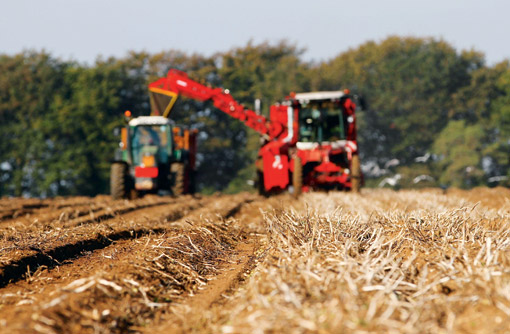Rapid burndown essential in high blight year

Crop variability and blight infections are the two big differences facing potato growers this season compared with last, as they consider their options for defoliation this coming harvest
Burning the leaf off as quickly as possible will be the priority for crops with blight infection, says Reuben Morris of Frontier Agriculture.
“Most potato crops have got blight in them,” he points out. “So maintaining blight protection into desiccation programmes will be important. There’s a likelihood of zoospores being around this year.”
Tank mixes of fungicides and desiccants can be done quite easily, so there’s no need for extra passes to get both jobs done, he advises. “Just be aware of maximum blight product applications per crop before you get to the final stage.”
The effects of the difficult growing season are evident, he reports. “Fields are patchy from waterlogging and rhizoctonia. Growers who used additional nitrogen to overcome leaching will be looking at very green crops late into the season.
“But where extra nitrogen wasn’t applied, some crops are running out of steam and will be quite early, given the unusual season. There are also a number of other different scenarios – remember that there were two plantings this season – up to late March and then May onwards, with very little planting done in April.”
So defoliation decisions will have to be made on a crop-by-crop basis, he suggests, with customer requirements for tuber size and quality also being important. “This is where yield digs and dry matter assessments will be even more important than usual.”
Dr Morris adds that the majority of growers now use a spray sequence for desiccation, rather than relying on one spray, with its associated risks. “And some will combine a spray sequence with flailing.”
Where flailing is to be used and the crop is still vigorous, growers should take the top off the crop with a desiccant first, he advises. “It doesn’t shock the crop as much and it involves less diesel use, so can have a financial advantage.”
Flailing and spraying is effective on very vigorous crops, which are common on fertile sites this year, he notes. “It’s important to leave about 20cm of stem with flailing to allow uptake of the desiccant. Also, move the flailed haulm off stems and into furrows, so that the spray can hit the stems directly.”
Desiccant choice is more straightforward this year, he believes. “There are currently no issues with dry soils, so the use of diquat will be easier. Most programmes will start with a low dose of diquat, followed by the main application of diquat plus Spotlight Plus (carfentrazone-ethyl).”
Spotlight is effective at preventing regrowth, while diquat is better at desiccating leaves, he points out. “Regrowth greatly increases the risk of tuber blight, and that’s a big risk this season. We need to avoid it.”
Another alternative is Harvest (glufosinate-ammonium), he highlights. “It shouldn’t be used until crop senescence starts or on very green crops, but it has a place in flail and spray programmes on vigorous crops.”
Topper Guide
The amount and type of haulm produced by different potato varieties and prevailing conditions play their part in making the operation a frustrating chore or a breeze. But so, too, can the topper design itself. But which is the most effective machine.
See Peter Hill’s guide to potato toppers
New desiccant
Quickdown from Certis joins the line-up of desiccants this year, having received registration towards the end of last year.
Based on pyraflufen, it is approved for use as a herbicide in potatoes, as well as a contact-acting desiccant for the destruction of potato haulm.
Its introduction should be welcomed, suggests John Keer of Richard Austin Agriculture, who points out that there is a limited range of treatments available when it comes to burndown.
“Having had some experience with it in trials done at the end of last season, Quickdown performs very well in terms of its speed of action and efficacy. So far, it seems to be at least equivalent to the use of carfentrazone-ethyl.”
He advises an application of diquat to kick off haulm destruction. “There’s a need to move fast once the correct tuber size distribution has been achieved, so that we prevent the crop progressing. Diquat is fast acting.”
Like Spotlight, Quickdown has a place in the second application. “It’s better at desiccating stems and completing haulm destruction than diquat, which is important to help with lifting in the following weeks.”
The aim at lifting is to have haulm which is completely senesced, he adds. “It needs to be dry and brittle with ‘give’, so that there’s no interference with working processes. The plant stems must be completely destroyed.”
Growers must observe a maximum individual dose of 0.8 litres/ha when using Quickdown as a desiccant. If it’s been used earlier on as a herbicide, the maximum total dose is 1.6 litres/ha.

